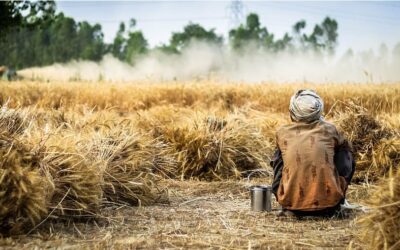Breathing new life into Kenyan cashew

Since the turn of the millennium, world trade in raw cashew nuts has more than doubled, amounting to 3.6 billion kilograms of nuts produced around the world. According to the UNCTAD, African producers have accounted for almost two-thirds of this growth, highlighting the significance of the cashew value chain in the economies on the continent. However, the Commodities report published by the same organisation shows that only a fraction of the value generated by this global boom in cashew demand reaches the producer, i.e. the smallholder farmer.
As I have previously noted, I believe cashew can be a game changer in bringing about widespread socio-economic development and generating a middle economy amongst rural communities. The Kenyan cashew nut industry has previously suffered from socio-economic, biological and technical constraints, and there have been over a dozen projects aimed at its revival in the last two decades. We use the word “revive” because the cashew sector in Kenya was once a powerhouse, with production declining from 38,000 MT in 1978 to a mere 5,000 MT at present. To put that in perspective, neighboring Tanzania today averages 300,000 MT of cashew annually, up from 145,000 MT in 1973.
We at the Empowering Farmers Foundation are excited to have begun a transformational and holistic project in Kenya, called Korosho Ni Maisha, Kiswahili for Cashew is Life. The aim of the project is to revive the cashew value chain in the country by empowering over 350,000 smallholder farmers to successfully nurture productive cashew trees and thereby boost their household income over the next 10 years. The project will oversee the integration of the cashew sector into national and county development priorities, bringing cashew farmer income up to USD 800 per acre per harvest, thus contributing a significant share in the farmers wallet.
What makes the Korosho Ni Maisha programme different from previous cashew revival projects in the country is EFF’s in-depth understanding and subsequent targeting of all the nodes in the cashew supply chain. We estimate that once this programme has run its course, Kenya could produce 300,000 MT of cashews every year.
Around the coastal counties of Kwale, Kilifi and Lamu, it is evident that there is potential for the cashew sector to return. According to the government cashew census conducted in 2009, there are currently two million cashew trees in the country. However, from extensive ground research that we have conducted over the last few years, it is evident that many of them have succumbed to logging, pests, diseases, age, or poor management. With specialist agronomist expertise and various agricultural technologies available today, it is possible to rejuvenate these trees, and also to enhance their yield performance.
The challenges to the cashew sector, however, go beyond the plants themselves. We identified three key problems:
- Absence of cashew specialist agronomy and a robust extension and advisory services system
- Weak research – extension – farmer linkage
- Poor farmgate pricing due to the existence of unregulated middlemen
We kicked off our initiative in 2020 by bringing all the stakeholders involved together and enabling dialogue on the present status of cashew in Kenya. We wanted to listen to everyone, especially the farmers, about what had gone wrong, and what could be done to resuscitate the cashew economy along the coast. After several virtual roundtables, we organised a two-day in-person workshop in Diani in October 2020, with over 30 participants including members of the Ministry of Agriculture, Livestock, Fisheries and Cooperatives (MoALFC); agricultural ministers of Coastal County Governments; representatives of parastatal institutions and agricultural research agencies; non-profits involved in the sector; smallholder farmers; and members of the press.
Dr. Theresia L. Munga, the Centre Director of The Industrial Crops Research Centre Mtwapa (ICRC) under the Kenya Agricultural & Livestock Research Organisation, speaking at a Korosho Ni Maisha Event
A few months later, in February 2021, we met with four Coastal Governors in Taita Taveta. I was able to attend this meeting and can say that the leaders were very excited about our proposal to revive the cashew value chain by rehabilitating the existing orchards and planting new high yield variety seedlings. With their support, we began further research into conducting our pilot project. Grassroot level studies found that the area in Kilifi County with the highest yielding cashew trees was Matsangoni Ward which has over 50,000 cashew trees. This is where we chose to launch our pilot project and in May, held an inaugural capacity building workshop for all of Kilifi County’s ward agricultural officers to introduce them to the larger Korosho ni Maisha project and specifically, the cashew audit and tree improvement exercise that was to take place in Matsangoni Ward.
The pilot programme is divided into two phases. The first phase began in June 2021 when we audited the entire ward to determine the total number of cashew trees, their health status, the interventions that they had undergone in the past, and the output we could expect from them. 51,972 trees were identified and examined and 1,560 farmers were interviewed in this effort led by an EFF team along with 24 youths from the community deployed as auditors. Based on this information and other statistics, we have planned tree improvement exercises for the second phase of the programme (August-September) where cashew trees will be provided with specific sanitation and nutrition solutions . The pilot is being led by two specialist agronomists from the Naliendele Research Institute, Tanzania, and their team of 24 spray operators and team leaders from Matsangoni.
The spraying, which will be done in four cycles, will protect against common pests and diseases like Powdery Mildew and Leaf Blight, which have hampered the yields in this region in the past. This will also include training sessions to teach farmers proper cashew agronomic methods required to care for their trees in a sustainable and self-sufficient manner.
In the Korosho Ni Maisha programme, we are very deliberate and intentional that the farmer and the community he dwells in, remains at the centre of our operations. In parallel, we have continuously engaged with the communities at large, launched sensitisation campaigns, and kept all the county and national government officials informed of our endeavours. We aspire to recentre agriculture in the narrative of Kenya, and we believe that revitalizing the cashew value chain is a step in making that happen. The Foundation is committed to offering the support and expertise needed to move smallholder cashew farmers from subsistence to commercial farming in the next 10 years.
To this end, we seek the support and collaboration of like-minded partners to scale this project up across all the wards of Kilifi County and then through the other targeted counties – we would be happy to hear from you!
Continue Reading
World Environment Day – Revisiting “Only One Earth”
Climate change is real. It affects developing nations disproportionately as compared to developed nations. Developing nations should not wait for help to do good for the environment but work towards ensuring that these challenges are met headlong. They should know that sustainability goals and development is not mutually exclusive.
World Food Crisis – How Africa can be the long-term solution
Africa has abundant resources to be the food factory for the world. This holds true especially for vegetable oil crops such as Sunflower, palm, soybean and rapeseed. Tanzania provides ideal conditions for growing sunflower at scale and supply it’s oil to the major consuming nations such as India.
Earth Day – Rising to the challenge of saving ourselves
We need to find solutions to ensure we can not just stop but reverse climate change. One solution is regenerative agriculture that can not only improve the yields for the farmers, but also reduce their carbon footprint.




0 Comments